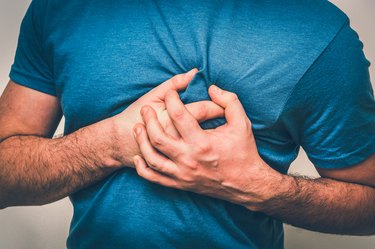
Your heart is cushioned within a double-layered sac called the pericardial sac or pericardium. There's a small amount of fluid between the two layers, up to 50 milliliters — not even two ounces, according to the Cleveland Clinic.
However, infections and other health problems can increase the level of fluid around the heart and threaten its ability to work normally. In most cases, the buildup of fluid (known as a pericardial effusion) is caused by inflammation of the pericardial sac (known as pericarditis), Cleveland Clinic explains.
Video of the Day
Video of the Day
Is Fluid Around the Heart Life-Threatening?
The sac around the heart may be able to adjust to some extra fluid, according to the Mayo Clinic. But it can become overwhelmed quickly and develop a condition called cardiac tamponade. This occurs when the excess fluid puts so much pressure on the heart that it affects circulation and keeps the heart from sending out needed oxygen throughout the body. Cardiac tamponade is a life-threatening situation and requires that the excess fluid be drained right away.
What Triggers Pericarditis?
There are many possible causes for excess fluid around the heart sac. "It's most commonly due to a virus or bacteria, inflammation of the heart sac after a heart attack, kidney failure and certain types of cancers that have spread such as breast, lung and lymphoma," says Michael Miller, MD, a cardiologist and professor of cardiovascular medicine, epidemiology and public health at the University of Maryland School of Medicine in Baltimore.
Other possible causes include rheumatoid arthritis, lupus, radiation therapy or chemotherapy, an underactive thyroid, trauma and some prescription drugs, such as hydralazine used to treat high blood pressure and phenytoin for epilepsy, according to the Mayo Clinic.
Read more: The 14 Best Foods for Your Heart
Know the Symptoms
Signs of too much fluid around the heart "can range from minimal — if any — symptoms to severe symptoms, depending on the size of the buildup," Dr. Miller says. "Symptoms include shortness of breath, especially when lying down, fatigue and chest discomfort."
In severe cases, he adds, "lightheadedness occurs as blood pressure drops, heart rate and breathing rate increase and engorgement of the neck veins may be seen." You might feel chest discomfort around the heart, often behind the breastbone or on the left side of the chest along with a sensation of fullness.
Your chest pain may even feel like a heart attack, according to the American Heart Association, The pain tends to result when layers of the inflamed pericardial sac push against the heart.
It's important to pay attention to subtle signs. If you're in tune with changes, you may be able to get medical care for a pericardium problem before the buildup of fluid around the heart has the time to get serious.
"Chest discomfort that occurs when lying down and is relieved when sitting up or leaning forward may be due to irritation of the heart sac because of infection or inflammation," Dr. Miller says. "That may lead to fluid buildup around the heart and should be evaluated by your doctor."
Shortness of breath is also a sign to call your doctor, according to the Mayo Clinic. In fact, call 911 if you feel any type of chest pain that lasts more than a few minutes, if breathing becomes hard or causes pain, or if you faint for any unknown reason.
Keep in mind that symptoms of fluid around the heart can be felt in many other ways, according to the UT Southwestern Medical Center. These can range from coughing, heart palpitations, nausea and swelling in the midsection or legs to restlessness, anxiety or confusion.
A variety of imaging tests may be used to diagnose and evaluate the condition, such as a cardiac MRI, CT scan, echocardiogram and electrocardiogram, says UT Southwestern. Treatments range from medications that reduce inflammation to surgical procedures to drain fluid.
- Mayo Clinic: “Pericardial Effusion”
- University of Texas Southwestern Medical Center: “Pericardial Effusion.”
- Cleveland Clinic: “Pericardial Disease”
- Michael Miller, MD, cardiologist, professor, cardiovascular medicine, epidemiology and public health, University of Maryland School of Medicine, Baltimore
- American Heart Association: “What Is Pericarditis?”
Is this an emergency? If you are experiencing serious medical symptoms, please see the National Library of Medicine’s list of signs you need emergency medical attention or call 911.